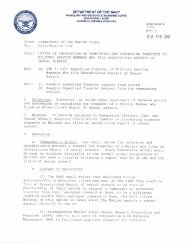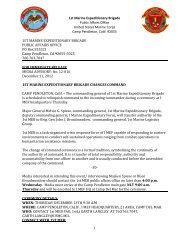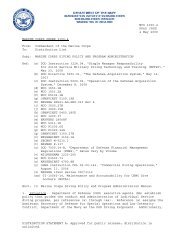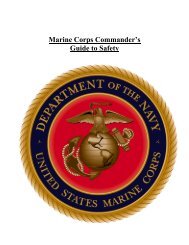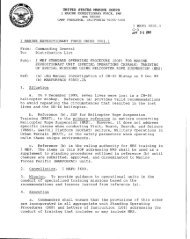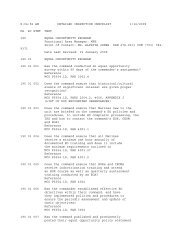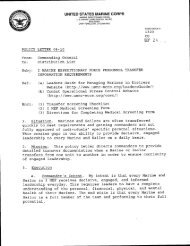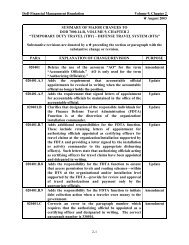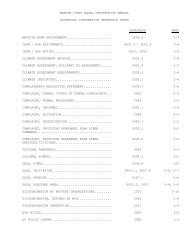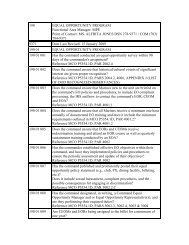personnel qualification standard (pqs) - I Marine Expeditionary ...
personnel qualification standard (pqs) - I Marine Expeditionary ...
personnel qualification standard (pqs) - I Marine Expeditionary ...
Create successful ePaper yourself
Turn your PDF publications into a flip-book with our unique Google optimized e-Paper software.
106 GROUND COMBAT ELEMENT (GCE)<br />
FUNDAMENTALS<br />
References:<br />
Ground Combat Element (GCE) 106<br />
a. MCWP 3-14.1, Light Armored Vehicle-25 Gunnery and Employment<br />
b. MCRP 5-12D, Organization of <strong>Marine</strong> Corps Forces<br />
c. MCWP 3-15.1, Machine Guns and Machine Gun Gunnery<br />
d. FMFM 6-9, <strong>Marine</strong> Artillery Support<br />
e. <strong>Marine</strong> Corps Common Skills Handbook, Book 1A, All <strong>Marine</strong>s, Individual<br />
Training Standards, May 2001<br />
f. <strong>Marine</strong> Corps Common Skills Handbook, Book 1B, All <strong>Marine</strong>s, Individual<br />
Training Standards, May 2001<br />
g. MCRP 3-15.2A, Mortars<br />
h. MCWP 3-12, <strong>Marine</strong> Corp Tank Employment<br />
i. NWP 3-09.11M/FMFM 1-7, Supporting Arms in Amphibious Operations<br />
j. FM 23/24, Dragon Medium Antitank/Assault Weapon System M47<br />
k. MCWP 3.16, Fire Support Coordination (FSC) in the Ground Combat Elements<br />
MARINE CORPS WARFIGHTING PHILOSOPHY<br />
The <strong>Marine</strong> Corps warfighting philosophy is based on rapid, flexible, and<br />
opportunistic maneuver capabilities. Maneuver warfare is a warfighting<br />
philosophy that seeks to shatter the enemy’s cohesion through a series of rapid,<br />
violent, and unexpected actions which create a turbulent and rapidly deteriorating<br />
situation with which he cannot cope (MCDP 1). Fire support in maneuver warfare<br />
produces combat power and is applied through combined arms.<br />
The MAGTF and GCE are combined arms teams by the nature of their<br />
organization. The GCE’s ability to deliver fire is most effectively employed when<br />
it creates a combined arms effect. Combined arms is the full integration of arms in<br />
such a way that in order to counteract one, the enemy must make himself more<br />
vulnerable to another. It pairs firepower with mobility to produce a desired effect<br />
upon the enemy (MCDP 1). In addition to the typical example of combined arms<br />
where indirect fire suppresses an enemy, enabling either maneuver or attack by<br />
direct fire, multiple supporting arms can create a combined arms effect. Artillery<br />
raids in the Gulf War intentionally attracted enemy counterfire to enable air attack<br />
of enemy radar and artillery units. The enemy had to suffer the effects of indirect<br />
fire or risk losing its own artillery assets. The 3d <strong>Marine</strong> air wing used a similar<br />
technique when conducting attacks against the Iraqi integrated air defense system<br />
(IADS). Suppression of enemy air defenses (SEAD) packages accompanied<br />
<strong>Marine</strong> aircraft conducting strikes against Iraqi positions and equipment. When<br />
Iraqi fire control radars were activated, the aircraft from the SEAD package attacked<br />
the radars with high-speed antiradiation missiles (HARMs). Once again,<br />
the Iraqis were placed in a dilemma. To defend against the air attacks, they placed<br />
their fire control radars in jeopardy.<br />
106-1



